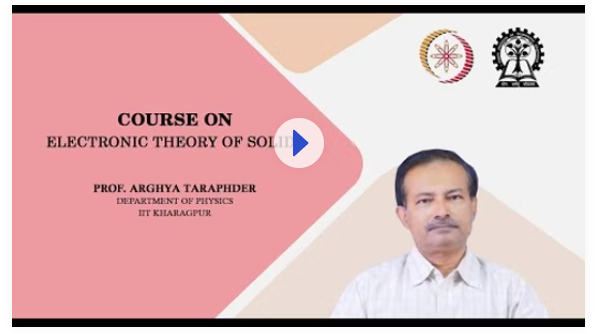Electronic Theory of Solids free videos and free material uploaded by Indian Institute of Technology, Kharagpur (IIT Kharagpur). This session contains about Electronic Theory of Solids Updated syllabus , Lecture notes , videos , MCQ , Privious Question papers and Toppers Training Provided Training of this course. If Material not uploaded check another subject
Week 1 : Free electron theory of metals, Fermi-Dirac distribution, Free electrons, boundary conditions, Density of levels in 1, 2 & 3 dimensions, Fermi momentum and Fermi energy, Connection between electron density and Fermi energy.
Week 2 : Independent electron systems, degenerate fermi gas: Specific heat, semiclassical theory of transport, Drude theory and Hall effect. Electronic properties of solids: the two-atom solid, theory of electrons in an N-atom solid, linear combination of atomic orbitals – band formation
Week 3 : Periodic potential, Bloch's theorem, tight binding approximation. Brillouin zones for square, triangular, cubic lattices and energy bands in reduced zone scheme.
Week 4 : Fermi surface in several cases, instabilities of the Fermi surface. Novel electronic structures: graphene and carbon nanotubes. Concept of symmetries and their relevance in emergent electronic properties, topological insulators.
Week 5 : Elementary concepts of low dimensional electron gas, quantum dot, 1D and 2D electron gas introduced. 2D electrons in a magnetic field, integer quantum hall effect. Spin filtering and magnetoresistance. Spintronics and its applications. Future directions in spin- or valley-tronics.
Week 6 : Magnetism and its origin, magnetization and susceptibility, dia-, para- and ferro-magnetism. Larmour diamagnetism.
Week 7 : Hund’s rule and paramagnetism, Van Vleck paramagnetism, Curie’s law. Thermal properties of magnetic insulators, Pauli paramagnetism.
Week 8 : Magnetic interactions, two-electron system, spin-spin interactions – exchange interaction, direct, super and itinerant exchange.
Week 9 : Magnetic order, Ising, XY and Heisenberg spin models, mean-field theory, ground states and thermodynamics.
Week 10 : Phenomenology of Superconductors, Superconductivity in metals and alloys, New Superconductors, Zero Resistance, Meissner Effect, London equation and two- fluid model. Attractive interaction, Cooper problem – instability of the Fermi surface, pair formation and binding energy.
Week 11 : BCS theory, tunneling, SC gap and transition temperature. Sp. heat jump at Tc, coherence length and penetration depth: electrodynamics of superconductors, Type-I and II SC, vortices.
Week 12 : Quantum interference, Josephson effect, SC junctions, squid and its application. Novel superconductors.
The course aims to introduce electronic properties of solids starting from a very simple example: the two-atom solid. Building on this, it develops the theory of electrons in an N- atom solid – the band concept and its application to electrical and thermal properties in solids. The novel electronic concepts related to graphene and carbon nanotubes are discussed. Concept of symmetries and their relevance in emergent electronic properties are also outlined.Magnetism of solids is introduced. Different types of magnetic states and their origin are outlined. Magnetisation and susceptibility in para and diamagnetic cases, their measurements and calculations in simple cases discussed. Concept of magnetic long range order is presented with examples. A magnetic Hamiltonian is described and solved in simple cases. Idea of mean-field theory outlined. Basic concepts of superconductivity are introduced with historical developments. The Cooper problem and BCS theory are worked out. Electrodynamics and applications of super conductivity discussed. Elementary concepts of low dimensional electron gas, quantum dot, 1D and 2D electron gas introduced. Basics of Quantum Hall effect discussed. Spin filtering and magnetoresistance introduced. Spintronics and its applications outlined. Future directions in spin- or valley- tronics discussed. INTENDED AUDIENCE : Physics, Chemistry, Material Science, Electronics, Electrical engineering, Nano-science and Nano-TechnologyPREREQUISITES : Elementary quantum mechanics. INDUSTRY SUPPORT : Physics, Chemistry, Material Science, Electronics, Electrical engineering, Nano-science and Nano-Technology

- 0 Reviews
- 8 Students
- 351 Courses

Write a public review